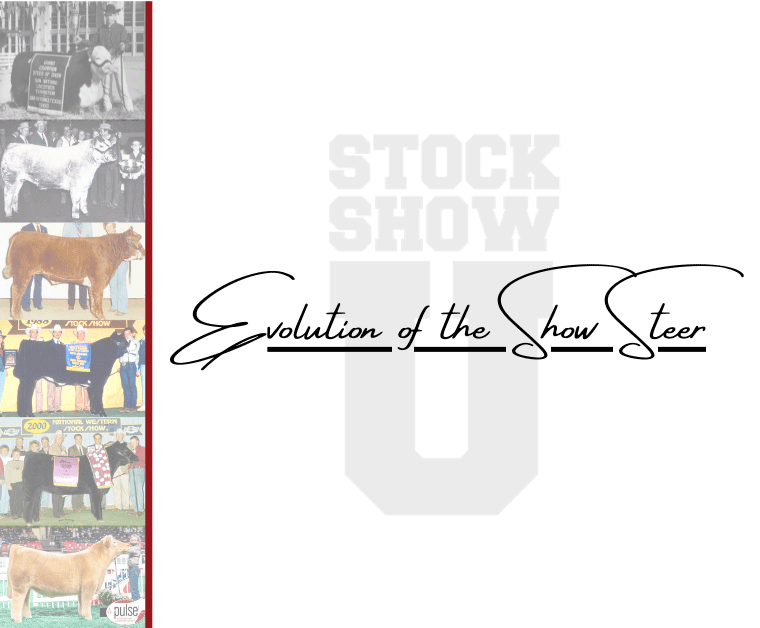Within the show cattle industry, the market animals that we are exhibiting have evolved from the champion steers that were selected back in the 1950s to the show steers that are seeing the backdrop today. Within this Stock Show University® article, we will talk about the phases and trends that the show cattle industry has seen.
In the 1950s and 1960s, cattle producers believed that the ideal market beef animal was small framed, so they would have an excellent feed efficiency—feeding less but still gaining weight at an appropriate rate. This trend also was relevant when it came to cattle that were being exhibited in the show ring. By the time the late 60s hit, producers were noticing that smaller framed cattle weren’t as efficient in range conditions compared to bigger framed cattle. In the early 1960s, champion steers were smaller framed but by the next year hit, champion steers were becoming bigger framed due to those industry demands. This was also the time when producers started to focus on crossbreeding to breed for the size and muscling that was desired in the show ring. The 1969 International was a pivotal one for the beef industry, when Dr. Don Good of Kansas State University selected “Conoco,” a Charolais-Angus crossbred steer, as Champion Steer of the show. “Conoco” was the first crossbred winner of a major show in modern times. He weighed 1,250 lbs. Typically today, crossbred steers are more likely to be selected over a purebred steer—due to genetic traits.
In the early to mid-1970s, there was still an emphasis on breeding cattle based on frame size and muscling. This was also the era that capitalized crossbreeding animals to get those desired traits. However, size was just starting to get out of control in many steer shows by the late 70s and early 80s. Some steers that were exceptional in their cutability were too lean and trim along with lacking body capacity. If you ever look at pictures from the cattle 80s that were exhibited at shows, most cattle were taller than their exhibitors.
Also, who remembers Sugar Ray in the early 1980s? Sugar Ray is known by many to be one of the first club calf bulls that hit the industry. He was a ChiAngus bull (Nero x Supermom) owned by Wilhelm Chianina and Bob May. One unit of semen for this bull would have costed you between $10.00 to $12.50.
In May 1988, the National Beef Conference announced their “Blueprint for the Right Kind” recommendation that cattle producers needed to focus on producing more moderate frame sized cattle and increase muscle thickness in market animals. Due to these recommendations, the typical show steer look once again started to change. But because breeders were focusing on muscle thickness and raising moderate framed cattle, structure was overlooked—which lead most cattle to be too straight in their structure, restricting mobility.
Since the early 2000s, the show steer industry and the beef industry itself have placed an emphasis on carcass traits, frame size, and structural correctness. Due to this, we now can see the evolution of the more modern sized animals with exceptional body capacity that are structurally sound on their feet and legs. Even throughout the early 2000s to modern times, we have been consistent on the basics of what we are looking for in the show ring.
Want to stay up to date on all the current trends and show results? Visit https://pulse.sullivansupply.com/


